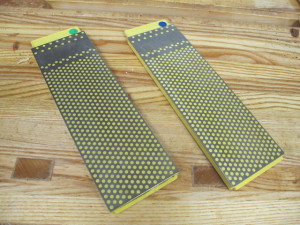To work effectively and safely cutting wood, most cutting tools require a razor sharp edge. Grinding will produce a sharp edge, but honing will produce a REALY sharp edge. There are basically three stones to hone a blade: oil stones, water stones and diamond ‘stones’, 4 if you include sandpaper.
This is a two part post – this part will give an overview of the types of honing stone available. Part two will look at the mechanics of sharpening a blade.
Oil stones and water stones are used with liquids which carries away the metal fines and keep the pores from clogging and rendering the stone useless.
Oil stones vary in coarseness ranging from coarse to ultra-fine. The most common types are:- silicon carbide (coarse, medium, and fine), aluminum oxide (coarse and medium), and Arkansas (soft is fine and hard is ultra-fine).
Silicon Carbide (Carborundum) – Silicon carbide oil stones are typically dark blue-black in color and relatively soft. They will wear away and ‘dish’ in the areas frequently worked, they are quite porous. A good general purpose first stone.
Aluminium Oxide (lndia Stones) – Aluminium oxide oil stones are black and a medium stone is a reddish-brown – relatively hard and less likely to wear than the silicon carbide stones. They are porous and will also soak up oil when new – fast cutting and easy to use. They are also good general purpose intermediate stone.
 Arkansas – Arkansas oil stones are expensive but high quality. They are the only natural sharpening stones still mined today. The soft Arkansas (fine) is usually white with a slight reddish or grey marbling and the hard Arkansas (ultra-fine) are almost always pure white and some have a translucency. They are very hard, will not wear but are fragile and easily broken if dropped (yes I speak from experience). Hard Arkansas stones are not porous, however the soft Arkansas stone is slightly porous and will soak up a small amount of oil when new. These are polishing stones. They are not fast cutting or easy to use, but will produce the sharpest cutting edges of any oil stone. I got mine here
Arkansas – Arkansas oil stones are expensive but high quality. They are the only natural sharpening stones still mined today. The soft Arkansas (fine) is usually white with a slight reddish or grey marbling and the hard Arkansas (ultra-fine) are almost always pure white and some have a translucency. They are very hard, will not wear but are fragile and easily broken if dropped (yes I speak from experience). Hard Arkansas stones are not porous, however the soft Arkansas stone is slightly porous and will soak up a small amount of oil when new. These are polishing stones. They are not fast cutting or easy to use, but will produce the sharpest cutting edges of any oil stone. I got mine here
What Oils to use – some people will say do not use vegetable or olive oil because it can become rancid, but I have used a light weight vegetable oil for years – heck my shop smells most of the time anyway. You can buy highly refined honing oils – which are mostly mineral oil. Others like Coke, contain “special secret ingredients”. If you don’t like the idea of rancid honing stones, all you really need is a natural petroleum based oil.
Maintaining Oil Stones – all stones will need cleaning periodically – all it takes is a little massaging with oil. Rub oil into the surface with your fingers this will loosen the debris from the pores. Then blot the surface of the stone. You will notice an immediate improved honing ability. Once in a while clean the stone up with soap and water after using and be sure it is dry before putting it back in the box – I have known people put them in the dish washer.
WATER STONES
The most common type of water stone is aluminum oxide. These come in four different grits ranging from coarse to ultra-fine that are classified like sandpaper: 800, coarse; 1000, medium; 1200, fine; and 6000, ultra-fine.
The softer water stones are usually used by moving the blades cutting edge into the stone. To avoid gouging the surface, tools narrower than 1/2″ should be moved away from the stone ie. pulling the blade backwards towards you.
Aluminium Oxide – 800, 1000, and 1200 grit water stones are aluminium oxide. These stones are relatively soft and likely to wear and dish even if used properly, however, they are easily flattened. They are porous and must be soaked in water overnight when new. They are fast cutting, easy to use.
Water Stones – as the name implies, are used with water. In fact they are best kept and stored submerged in water. The water keeps the stone clean and able to cut well. If left out of water they will glaze over and almost immediately stop cutting. You need to use distilled water, I add a drop or two of chlorine bleach to prevent the growth of bacteria.
Maintenance -The water stone will dish after use even with the best of care. Either after using these stones, or before each use, they should be flattened. Just how soft these stones are will be very evident the first time you flatten one.
To flatten a water stone, lay a sheet of 220-grit wet/dry, silicon carbide sandpaper on a flat, waterproof surface. A piece of thick glass works well.
Apply a generous amount of water to the abrasive sheet. Place the stone on the sheet and rub the stone over the abrasive sheet in a figure of eight motion. Work the stone until the stone is flat. You will find that this process takes only a few minutes.
Once you have flattened the stone it is a good idea to just ‘break’ the sharp edges to prevent them from chipping.
check out waterstone pond by frank klausz
These stones are not stone at all but are made of acrylic or steel with diamond particles of varying coarseness embedded into the surface.
Because of the rigid metal backing, these diamond stones will cut with the tool moving in any direction.
Diamond stones need little or no maintenance. To clean a diamond stone simply wash with soap and water.
One of the most important skills a woodworker can acquire is the ability to sharpen tools well and easily but that’s for another post…



Useful and interesting Michael – thanks.
Glad that you found it interesting – stay ‘honed’ for Part 2 – how to sharpen a blade.